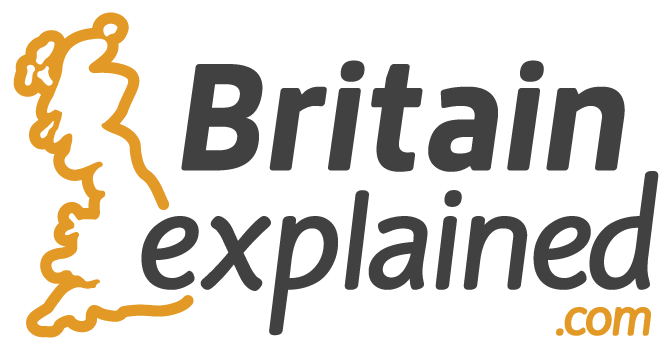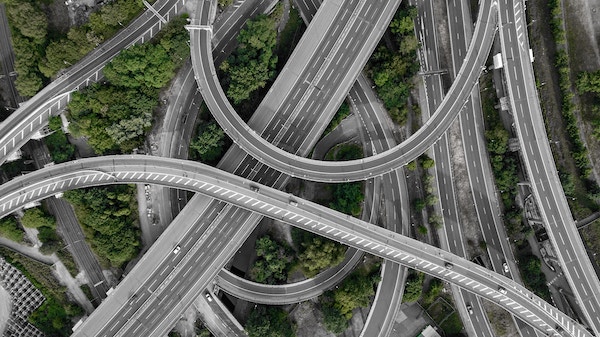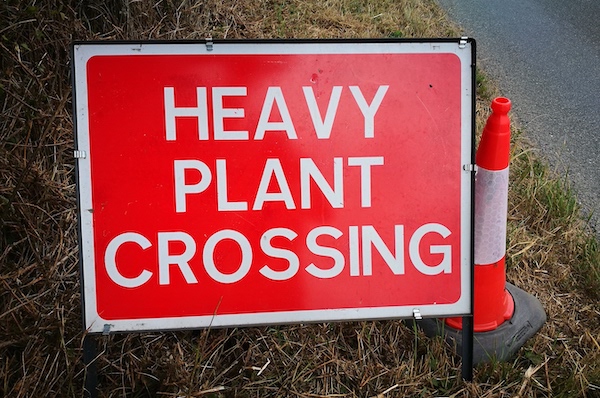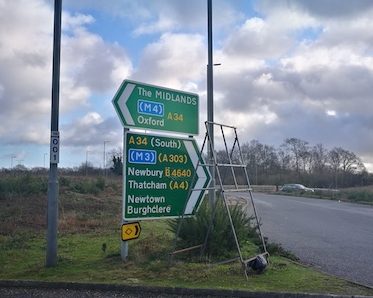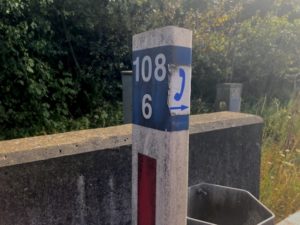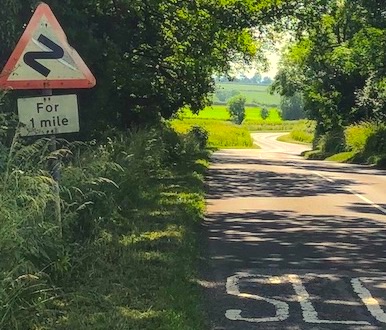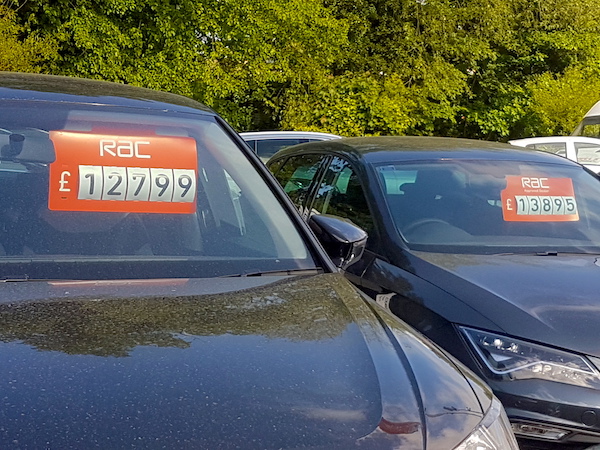The speed limit depends on the type of vehicle and type of road.
Key things to remember:
- If there are street lights, the speed is 30 miles per hour unless you see a different speed limit.
- If you are towing something, the maximum speed limit is often lower than normal
- Motorhomes are classed as ‘goods vehicles’ if they are used like a van
- Vehicles with over 8 passenger seats or weighing over 3.5 tonnes must have a speed limiter added
- The National Speed Limit sign is white with a black diagonal stripe. The National Speed limit for cars is 30mph in urban areas, 60mph on single-carriage roads, 70mph on dual carriageways and motorways.
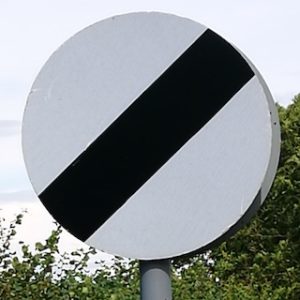
There are full details about speed limits on the main government website.
Over 50% of the price of petrol and diesel is tax (fuel tax and VAT). The price also changes with the price of oil.
Many petrol stations now have a self-service option. This means you pay at the pump before you start fuelling the car. You will need a debit card, credit card or phone app to be able to do this. You can usually also pay cash to the person in the forecourt shop.
It is illegal to hold a mobile phone while you drive. If you do, you can get 6 penalty points and a £200 fine. It is legal to use a hands-free system.
Be aware using a mobile phone is risky. 32 people died in 2016 because they were using a mobile phone while driving.
Britain has strict rules on driving after drinking alcohol. You might have too much alcohol in your blood after just one alcoholic drink, or even several hours after you finished your drinks.
The rules say you must not be ‘in control’ of a car after drinking too much. This includes being in a parked car alone, or sleeping in the car.
Anyone found with a level of alcohol over the limit would be banned from driving for at least 12 months, pay a fine of up to £5,000 and might go to prison.
- Find the latest details about the drink-drive limit on the main government website.
Driving after taking drugs means you risk a driving ban of 1 year, a criminal record and a fine of up to £5,000.
Some medicines are also included (but if you are taking them in the way your doctor told you, you would not be breaking the law).
- Go to the main government website for full details about driving and drugs.
If there is a belt fitted on the seat, you must wear the seatbelt (it is usually only vintage cars that don’t have fitted seatbelts). If you don’t wear a seatbelt, you might need to pay a fine of £500.
Only one person is allowed on each seat. Young children should be in a special seat (see next question). Special seatbelts are available for disabled people, or people in wheelchairs. Search for one online.
Be aware there a high chance of death in a road accident if you do not wear a seatbelt – police data shows that in 2017, about 27% of road deaths were from people not wearing a seatbelt.
You are allowed to remove the seatbelt if you are reversing.
- Go to the main government website for more details about seatbelt law.
Children under 135cm tall (or under 12 years old) always need a special safety seat. The kind of seat depends on the child’s height and/or weight. When you buy a child seat, make sure you get the right size.
You could have to pay a fine of £500 if you don’t have children in the correct seat. Read more on the main government website.
- The Child Car Seats website can help you to choose the correct seat.
If you do something that is against the law while you are driving, you might have penalty points put on your UK driving licence. If you get more than 12 points over 3 years, you will lose your licence.
If you are a new driver, you will lose your licence if you get more than 6 points within 2 years of passing your test.
- Go to the main government website for more details about penalty points.
This is a Penalty Charge Notice, another word for a fine. It could be for speeding, parking badly or not paying a charge, for example the Congestion Charge.
Car showing a white sign with a red L have a learner driver (someone who has not passed their test). In Wales it could be a white sign with a red D.
Cars showing a white sign with a green P have a driver who has passed their test recently.
Be aware that not all new drivers have a P sign on their car.
ANPR = Automatic numberplate recognition. These are cameras that can read car registration plates. ANPR is used in car parks, petrol stations and also around some areas of the country to reduce crime.
Drivers should only flash their headlights to say ‘watch out – I am here!’ But many people do it for other reasons (these are not strictly legal):
- On roads only wide enough for one car it might mean ‘you can come, I’ll wait’
- In the dark, it might mean ‘thank you’ (in the day, people usually raise their hand). When a car is driving away from you, they will often briefly flash their indicator lights or hazard lights as a way to say thank you.
- If a car is driving towards you, it might mean ‘watch out! There is danger ahead’ (maybe a long traffic jam or a flood)
- Between buses or lorries, it might mean ‘hello!’
There are a lot of cars in London. Think carefully before driving a car into London or owning a car in London, for these reasons:
- There is lots of public transport
- Driving can be very slow
- Parking is expensive and difficult to find
- You will have to pay a fine if you drive on bus lanes at the wrong time
- You cannot stop on red routes most of the time (and will have to pay a fine if you do). Red routes are main roads with 2 red painted stripes at the side.
- You need to pay the Congestion Charge for driving within central London. You might also need to pay the ULEZ charge, unless your car has very low emissions.
- There are car-sharing clubs that you can join. This can be cheaper and easier than owning a car
- It is easy to get to other cities in the UK by train or coach.
Read the questions below for more information about different charges and rules.
If you drive inside London’s Inner Ring Road between 07:00 and 22:00 (on every day except December 25), you might have to pay a charge. There are 2 charges: the Congestion Charge and the ULEZ charge.
- The Congestion Charge applies to the most central part of London. There is usually a £15 daily charge every day of the year, except December 25-January 1.
- You might also need to pay the ULEZ (ultra low emissions zone) charge, especially if you have a diesel vehicle.
The official Transport for London website will tell you what you need to pay. It has a map of the charging areas a link to payment. Beware of fake websites offering to take your payment.
If you live in the central area, the amount you pay is lower. You will need to ask Transport for London for the discount.
There is a fine if you do not pay.
Large diesel vehicles (lorries, buses, vans and motorhomes) usually need to pay a daily charge within London if they don’t meet air quality standards. The daily charge is £100-300. There is a fine if you do not pay.
- Find out if you need to pay for your vehicle in the Low Emission Zone on the Transport for London website.
The ULEZ (Ultra Low Emission Zone) is designed to make the air quality in London better.
The ULEZ area goes up to (but does not include) the North Circular Road (A406) and South Circular Road (A205). Vehicles (including cars and motorbikes) have to pay a daily charge unless they have very low exhaust emissions. The charge is payable at any time of day, every day of the year, except December 25.
- From August 29, 2023 there are plans to increase the ULEZ to the whole of London within the North Circular (A406) and South Circular (A205) roads. For cars, the charge will be £12.50 although new and low polluting models will not have to pay.
- For more information and details of how to pay, go to the Transport for London website.
Red routes are the main highways in London. They have two red lines painted on each side of the road. About 30% of traffic uses a red route.
During the day, you are not allowed to stop on a red route. There are other rules too – look at the signs at the side of the road. You might have to pay a fine if you don’t follow the rules.
London has 3 ring roads:
- The Ring Road (sometimes called the Inner Ring Road) goes around the Congestion Charge zone, but is not part of it.
- Further out is the North Circular (the A406) which links to the South Circular (the A205).
- Outside London is the M25 motorway, sometimes called the London Orbital.
There almost always delays when driving in London! The Transport for London website status updates will tell you about the worst areas for that day.
With car share, you just pay for using a car when you need it. From 30 minutes to longer (like a weekend) is possible. After you join the club, you pay direct from your bank account, for time and miles. The cars are usually parked on a street and around London there are lots of places to pick one up.
- The Transport for London website has a map of where to find cars and a list of car share clubs.
Postcodes in Britain are special because they have so much information – not just the town or area, but also the street. Sometimes one big building has its own postcode.
If you are using a postcode to find a place using a satnav system, be aware that in rural areas one postcode might cover up to 80 houses. These might be over a large area.
A dual carriageway is a road with two lanes each side. The maximum speed for cars is 70mph.
Some motorways, including the M25, and parts of the M3 and M1, have been made into ‘smart motorways’ that help reduce traffic jams. These have lots of overhead electric signs and a speed limit that can change to help traffic flow. Special cameras measure the average speed of each vehicle so make sure you only travel below the speed shown on the sign.
Often there is no hard shoulder (a lane at the side for emergencies). Instead, all lanes are open to traffic. If your car has a problem, try to leave the motorway or stop in an emergency refuge. If you can’t, pull over as far to the left as you can and switch on your hazard lights. Do not stay in the car.
- Read more about emergencies.
The hard shoulder is the lane on a motorway on the far left hand side. It is usually only for emergency vehicles. You can also stop here if you have an emergency.
- Read more about emergencies.
This is the strip of land in the middle of the motorway or dual carriageway. There is also a low fence or concrete wall.
A red ‘x’ means there is a problem in that lane (for example, a broken car). You must move to another lane. It can be dangerous of you don’t. You might also have to pay a fine.
Cars are not normally allowed in bus lanes. Look for signs to tell you when it is OK for cars – but be aware the signs can change along one road.
In London it is common that cars cannot use the bus lanes between 07.00 and 19.00, 7 days a week. There are cameras watching the bus lanes – you will have to pay a fine if you drive a car in the bus lane during those times. Sometimes motorcycles and bicycles can use the bus lane.
It can be difficult to find places to park in towns and cities. In many areas you must pay for parking. Look out for painted lines along the side of the road.
- One yellow line means there is a parking restriction (look for yellow signs on lampposts giving more information).
- Double yellow lines means you must not park.
- Red lines means you cannot stop, even for a short time.
- Some streets are free to park on, others need a parking permit.
If you ignore the rules you can get a fine. In some areas your car might be towed away.
You will probably have to pay for parking, either on the street or in a car park. The Parkopedia website lists public car parks. Another option is Just Park, which lists private off-road parking spaces that are available for hire.
Most roads are free to drive on, including motorways. However, there are a few exceptions:
- The M6 Toll Road. This is a stretch of motorway that offers a quicker alternative to the main M6 (which is free) near Birmingham. Go to the M6 toll website.
- The Dartford Crossing. This river crossing on the east side of London lies between junctions 31 and 1A of the M25. It has a charge (called the Dart Charge) during most of the day. You must pay online up to midnight the day after you cross it. Be aware the Dart Charge uses the same ‘C’ logo as the London Congestion Charge, but it is not the same thing.
- Bridges and tunnels. Some bridges and tunnels have a charge. This includes the Tamar bridge in Devon and the Humber bridge in Yorkshire.
- Charges to drive in city centres. You need to pay to drive in the central area of London, Durham and Birmingham (and soon Oxford and Bristol). This is to help reduce pollution and congestion.
- Ferries. In a few rural locations (for example at Reedham on the Norfolk Broads) there are car ferries instead of a bridge.
Read more about toll roads on the main government website.
In cold weather, salt and sand is spread on main roads, but this is not useful when there is lots of snow. Sometimes there are not enough snowploughs. Even motorways can get blocked.
Stay at home until the snow has melted if you can. If you must go out, take blankets, water, food, a mobile phone and a spade in case you get stuck.
Most people do not put winter tyres on their car, which can make things worse. In 2018, heavy snow and ice led to 13,000 crashes over 4 days.
Before you are allowed to drive a car in Britain you must have a valid driving licence, be aged 17+ and able to read a car number plate from 20 metres. You must also have car insurance. The rules are called the Highway Code.
You can drive a car with a foreign driving licence for the first year you live in the UK. After that, it depends on the country where you got your driving licence.
- If your licence is from a European Union country, you can currently continue to drive in the UK on that licence.
- If you are from a ‘designated country’ (including Australia, South Africa and Zimbabwe), you can exchange the licence from your country with a UK licence.
- People from most other countries will need to do the full UK driving test.
The main government website has more information about driving licences.
If you have a foreign driving licence and need to change it to a UK driving licence, you must first apply for a provisional licence (see above). You must then pass both the theory test and the driving test.
You must have lived in Britain for at least 185 days in the 12 months before you take your test.
- See more on the main government website.
Distances on roads are still shown in miles.
A mile is 1.6 km. (5 miles = 8km).
Speeds are shown in miles per hour (mph). 50mph = 80kmh.
Road signs sometimes show distances in yards.
A yard (yd) is nearly a metre (1 yard = 0.9m).
There are 1,760yds to a mile.
Yes, you are allowed to use a left-hand drive car, however it is more difficult to get the right position on the road because you are driving near the kerb.
Other things to consider:
- Your headlight direction might need adjusting.
- If the speed dial only shows km/hour, make sure you know the miles/hour speeds too.
- Tell your UK insurance company you have a left-hand drive car if you are going to be living here.
